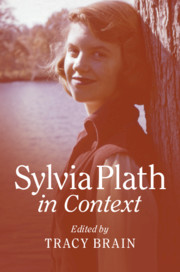Book contents
- Sylvia Plath in Context
- Sylvia Plath in Context
- Copyright page
- Contents
- Notes on Contributors
- Acknowledgements
- Chronology
- Abbreviations and Textual Note
- Key Archives
- Introduction
- Part I Literary Contexts
- Chapter 1 Plath and the American Poetry Scene
- Chapter 2 The Dominant Trends in British Poetry of the 1950s and Early 1960s
- Chapter 3 Plath and the Classics
- Chapter 4 Plath and the Radio Drama
- Chapter 5 ‘Sincerely Yours’: Plath and The New Yorker
- Part II Literary Technique and Influence
- Part III Cultural Contexts
- Part IV Sexual and Gender Contexts
- Part V Political and Religious Contexts
- Part VI Biographical Contexts
- Part VII Plath and Place
- Part VIII The Creative Afterlife
- Bibliography
- Index
Chapter 1 - Plath and the American Poetry Scene
from Part I - Literary Contexts
Published online by Cambridge University Press: 03 August 2019
- Sylvia Plath in Context
- Sylvia Plath in Context
- Copyright page
- Contents
- Notes on Contributors
- Acknowledgements
- Chronology
- Abbreviations and Textual Note
- Key Archives
- Introduction
- Part I Literary Contexts
- Chapter 1 Plath and the American Poetry Scene
- Chapter 2 The Dominant Trends in British Poetry of the 1950s and Early 1960s
- Chapter 3 Plath and the Classics
- Chapter 4 Plath and the Radio Drama
- Chapter 5 ‘Sincerely Yours’: Plath and The New Yorker
- Part II Literary Technique and Influence
- Part III Cultural Contexts
- Part IV Sexual and Gender Contexts
- Part V Political and Religious Contexts
- Part VI Biographical Contexts
- Part VII Plath and Place
- Part VIII The Creative Afterlife
- Bibliography
- Index
Summary
Jonathan Ellis situates Plath’s work in relation to the American poetry scene of the 1950s and early 1960s. He analyses how a mid-century generation of poets like John Berryman, Elizabeth Bishop and Robert Lowell responded to Modernism through the birth of Confessionalism. Ellis draws on Plath’s letters, journals, poems and stories to analyse her own role in and thinking about this aesthetic turn. He considers the impact of Plath’s contemporaries, Adrienne Rich and Anne Sexton, as well as Edith Sitwell, Marianne Moore, May Swenson and Isabella Gardner. Situating Plath’s poetry in relation to the work of these poetic godfathers and godmothers, Ellis looks in particular at questions of gender and nationality.
- Type
- Chapter
- Information
- Sylvia Plath in Context , pp. 12 - 21Publisher: Cambridge University PressPrint publication year: 2019

